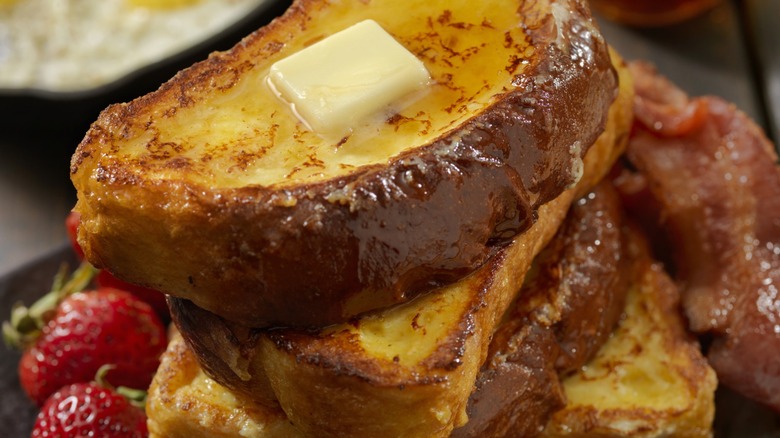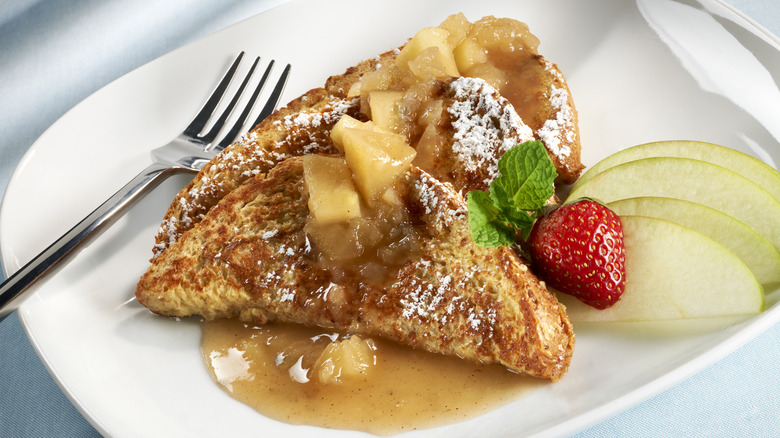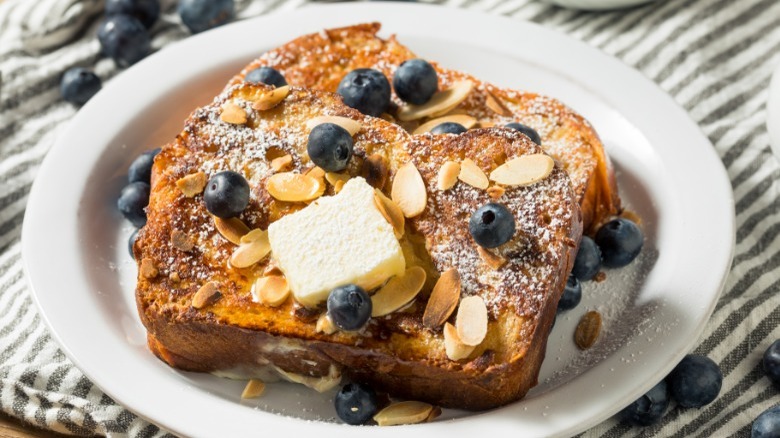The Crunchy Step You Shouldn't Skip When Making French Toast
French toast is an iconic breakfast or brunch treat, and the classic recipe is pretty set in stone. You really only need some bread, eggs, sugar, cinnamon, vanilla, and a skillet to turn your bread into that warm and crispy toast — plus maple syrup to drown the final product in. However, according to TikTok user @sheenamarie3568, it turns out this tried and true recipe might be missing one essential — and extra crunchy — step.
@sheenamarie3568 20+ years of making French toast wrong. #frenchtoast #todayyearsoldwhen #fyp #vote #election2022 #electionday #breakfastfordinner
The video, which claims you're "supposed" to toast your bread before dipping it in the egg and sugar mixture, has generated thousands of impassioned reactions. While some commenters seemed intrigued and wanted a follow-up video of the finished product, others weren't convinced that the new hack would level up their breakfast game.
Though it may seem strange — "I have never seen or heard that in my life," commented TikTok user @missdavis52 — toasting your bread before making French toast helps trap moisture inside the bread, while the outside remains crisp and crunchy.
To toast or not to toast
There's a reason so many people claim French toast is better with oven-roasted bread, or even just bread that's seen the inside of your toaster first. Moisture is everything when trying to make the perfect French toast, and toasting or roasting the bread first is key to ensuring the inside of your toast is soft and fluffy, not soggy and mushy, and that the outside is expertly crisped.
The squishiness of French toast comes down the egg-based liquid you dunk it in, and how that liquid is ultimately absorbed into whatever bread you choose to use. Normally, stale bread is used because — not to state the obvious — it's more sturdy; so, by pre-toasting the bread, you're essentially achieving the same effect. But, what's different about this method is that the bread's normal texture and flavor will be better maintained than they would have been if you had let it go stale.
While any kind of bread will do for making French toast, the bread you choose will ultimately determine a lot of the final flavor profile and texture. If you happen to like a mushier and sweeter French toast doused in syrup, breads like brioche or challah are the way to go. If brioche sounds a little too typical for your liking, Hawaiian roll French toast gives brioche a run for its money.
Give it even more of a crunch
The point of pre-toasting your bread is to ensure your French toast has more of a crunch than it would otherwise, while maintaining a pillowy interior. However, there are plenty of other ways to add even more of a crisp to your French toast. For example, in France, French toast is called "pain perdu," and is made with stale bread that's dipped in chopped almonds on one side and cooked on a skillet. By incorporating almonds, the French add another layer of crisp crust.
Another way to achieve that satisfying crunchy bite is to use bread with more texture. Although they may not taste as sweet, loaves of bread with poppy seeds or nuts, such as pecans, will provide your French toast with new layers of both flavor and texture. There are also French toast recipes that involve battering your bread in rice cereal or cornflakes, much like a piece of fried chicken, ensuring you get a crispy shell around that soft and sugary center. If you'd prefer to stick to classic bread choices, a crunch can always be achieved by adding toppings to your final product — any kind of cereal, granola, or thinly sliced nut would probably taste delicious.



